Day Seven
August 14th
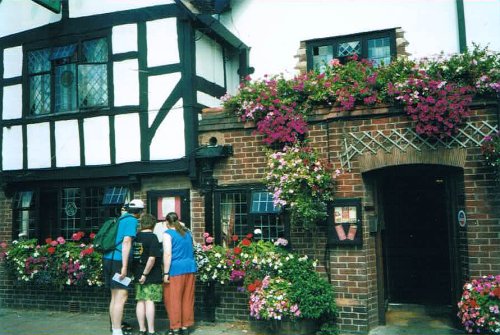 We
took the train from Paddington Station to Stratford-Upon-Avon,
a mecca for Bard devotees. A friend from the north of England came to
meet us at the station. The whole town is quaint, sometimes a little
too consciously, but in general the quaintness seemed real. Almost
all of the houses and buildings were timber-framed. William
Shakespeare (1564-1616) permeated the town. We found him everywhere
from street names to the ubiquitous memorials to him to the theaters
presenting productions of his plays.
We
took the train from Paddington Station to Stratford-Upon-Avon,
a mecca for Bard devotees. A friend from the north of England came to
meet us at the station. The whole town is quaint, sometimes a little
too consciously, but in general the quaintness seemed real. Almost
all of the houses and buildings were timber-framed. William
Shakespeare (1564-1616) permeated the town. We found him everywhere
from street names to the ubiquitous memorials to him to the theaters
presenting productions of his plays.
We ate lunch at the White Swan Hotel, which was beautifully
“authentic” inside, with low-slung, heavy ceiling beams and an
utter lack of windows.
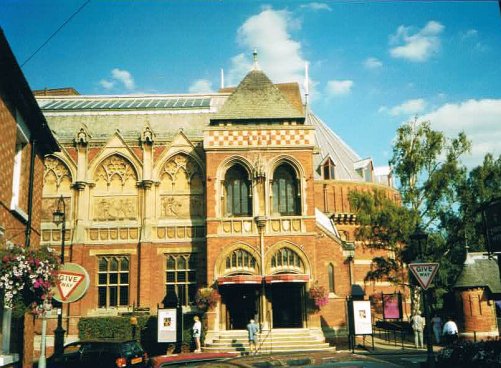 We
watched the Royal Shakespeare
Company's production of "The Taming of the Shrew" in a
modern theater with subtly Elizabethan features. The acting was
superb, and we all thought that the experience was the highlight of
the trip. The special effects were flashy and impressive and the
theater was very atmospheric. It reproduced Elizabethan theater
arrangements without specifically duplicating one of Shakespeare's
theaters.
We
watched the Royal Shakespeare
Company's production of "The Taming of the Shrew" in a
modern theater with subtly Elizabethan features. The acting was
superb, and we all thought that the experience was the highlight of
the trip. The special effects were flashy and impressive and the
theater was very atmospheric. It reproduced Elizabethan theater
arrangements without specifically duplicating one of Shakespeare's
theaters.
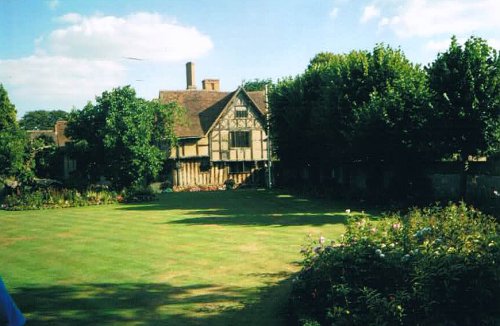 After
the play, we went to Hall's Croft, one of the Shakespeare houses.
Shakespeare's daughter Susanna married John Hall, a doctor who
invented a famous cure for scurvy. The house was full of tools and
medicinal exhibits, including two cases out of the doctor's casebook.
There was original glass in one of the upstairs windows. The bedrooms
were set up to look like a master's and servant's rooms, with period
furniture. The kitchen was very neat, with herbs hanging from the
heavy-beamed ceiling and an amazing hearth. The gardens at Hall's
Croft were also lovely, with medicinal plants and herbs.
After
the play, we went to Hall's Croft, one of the Shakespeare houses.
Shakespeare's daughter Susanna married John Hall, a doctor who
invented a famous cure for scurvy. The house was full of tools and
medicinal exhibits, including two cases out of the doctor's casebook.
There was original glass in one of the upstairs windows. The bedrooms
were set up to look like a master's and servant's rooms, with period
furniture. The kitchen was very neat, with herbs hanging from the
heavy-beamed ceiling and an amazing hearth. The gardens at Hall's
Croft were also lovely, with medicinal plants and herbs.
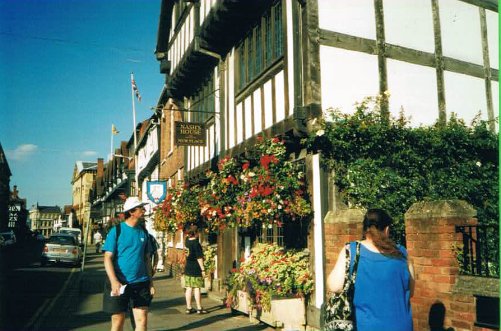
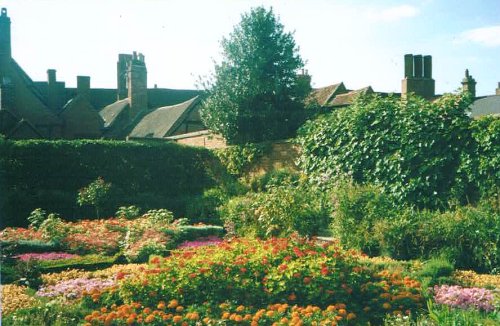 We
ate mulberries from a tree in the garden, staining our hands. A guide
told us that that is the origin of the phrase “caught red-handed.”
He had invited us to help ourselves, so we weren't really stealing.
We
ate mulberries from a tree in the garden, staining our hands. A guide
told us that that is the origin of the phrase “caught red-handed.”
He had invited us to help ourselves, so we weren't really stealing.
It was getting late as we finished
looking at Hall's Croft, and we wanted to see as many of the
important places in Shakespeare's life as possible, so we went to
Nash's House next. This is where Shakespeare's granddaughter
Elizabeth lived. We also saw New Place. In his later years, when
Shakespeare had become relatively wealthy and successful, he bought a
fine house at New Place on the corner of Chapel Street and Chapel
Lane. The house was demolished in 1759, so there is not much to see
there. Today, it consists of a sign marking its location and a lovely
Elizabethan knot garden.
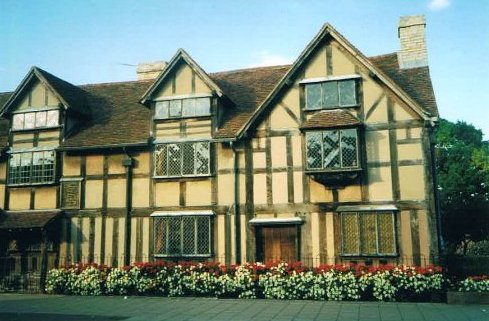 We
saw Shakespeare's birthplace, although it closed before we had time
to see the interior. Then we walked to Holy
Trinity Church, where Shakespeare is buried next to his wife Anne
Hathaway. The church has transpects from the mid-13th
century and later additions from the 18th century. There,
we saw the bust of Shakespeare that is said to most accurately
reflect his appearance in life. Although it was created seven years
after his death, his wife was still alive and people generally assume
that she made sure it was a good likeness.
We
saw Shakespeare's birthplace, although it closed before we had time
to see the interior. Then we walked to Holy
Trinity Church, where Shakespeare is buried next to his wife Anne
Hathaway. The church has transpects from the mid-13th
century and later additions from the 18th century. There,
we saw the bust of Shakespeare that is said to most accurately
reflect his appearance in life. Although it was created seven years
after his death, his wife was still alive and people generally assume
that she made sure it was a good likeness.
 We
took the 19:55 train home. There was a trackside fire caused by some
gas cylinders in Slough! They put the fire out, but we had to switch
to a local train that stopped at every station, and the trip took a
long time. We got off at Waterloo and took the Tube at the Jubilee
Line, which was an experience. It is deep underground, so we had to
take three escalators to get back to the ground level and finally get
back to our hotel.
We
took the 19:55 train home. There was a trackside fire caused by some
gas cylinders in Slough! They put the fire out, but we had to switch
to a local train that stopped at every station, and the trip took a
long time. We got off at Waterloo and took the Tube at the Jubilee
Line, which was an experience. It is deep underground, so we had to
take three escalators to get back to the ground level and finally get
back to our hotel.
BACK
 We
took the train from Paddington Station to Stratford-Upon-Avon,
a mecca for Bard devotees. A friend from the north of England came to
meet us at the station. The whole town is quaint, sometimes a little
too consciously, but in general the quaintness seemed real. Almost
all of the houses and buildings were timber-framed. William
Shakespeare (1564-1616) permeated the town. We found him everywhere
from street names to the ubiquitous memorials to him to the theaters
presenting productions of his plays.
We
took the train from Paddington Station to Stratford-Upon-Avon,
a mecca for Bard devotees. A friend from the north of England came to
meet us at the station. The whole town is quaint, sometimes a little
too consciously, but in general the quaintness seemed real. Almost
all of the houses and buildings were timber-framed. William
Shakespeare (1564-1616) permeated the town. We found him everywhere
from street names to the ubiquitous memorials to him to the theaters
presenting productions of his plays.
 We
watched the
We
watched the  After
the play, we went to Hall's Croft, one of the Shakespeare houses.
Shakespeare's daughter Susanna married John Hall, a doctor who
invented a famous cure for scurvy. The house was full of tools and
medicinal exhibits, including two cases out of the doctor's casebook.
There was original glass in one of the upstairs windows. The bedrooms
were set up to look like a master's and servant's rooms, with period
furniture. The kitchen was very neat, with herbs hanging from the
heavy-beamed ceiling and an amazing hearth. The gardens at Hall's
Croft were also lovely, with medicinal plants and herbs.
After
the play, we went to Hall's Croft, one of the Shakespeare houses.
Shakespeare's daughter Susanna married John Hall, a doctor who
invented a famous cure for scurvy. The house was full of tools and
medicinal exhibits, including two cases out of the doctor's casebook.
There was original glass in one of the upstairs windows. The bedrooms
were set up to look like a master's and servant's rooms, with period
furniture. The kitchen was very neat, with herbs hanging from the
heavy-beamed ceiling and an amazing hearth. The gardens at Hall's
Croft were also lovely, with medicinal plants and herbs.
 We
ate mulberries from a tree in the garden, staining our hands. A guide
told us that that is the origin of the phrase “caught red-handed.”
He had invited us to help ourselves, so we weren't really stealing.
We
ate mulberries from a tree in the garden, staining our hands. A guide
told us that that is the origin of the phrase “caught red-handed.”
He had invited us to help ourselves, so we weren't really stealing.
 We
saw Shakespeare's birthplace, although it closed before we had time
to see the interior. Then we walked to
We
saw Shakespeare's birthplace, although it closed before we had time
to see the interior. Then we walked to  We
took the 19:55 train home. There was a trackside fire caused by some
gas cylinders in Slough! They put the fire out, but we had to switch
to a local train that stopped at every station, and the trip took a
long time. We got off at Waterloo and took the Tube at the Jubilee
Line, which was an experience. It is deep underground, so we had to
take three escalators to get back to the ground level and finally get
back to our hotel.
We
took the 19:55 train home. There was a trackside fire caused by some
gas cylinders in Slough! They put the fire out, but we had to switch
to a local train that stopped at every station, and the trip took a
long time. We got off at Waterloo and took the Tube at the Jubilee
Line, which was an experience. It is deep underground, so we had to
take three escalators to get back to the ground level and finally get
back to our hotel.